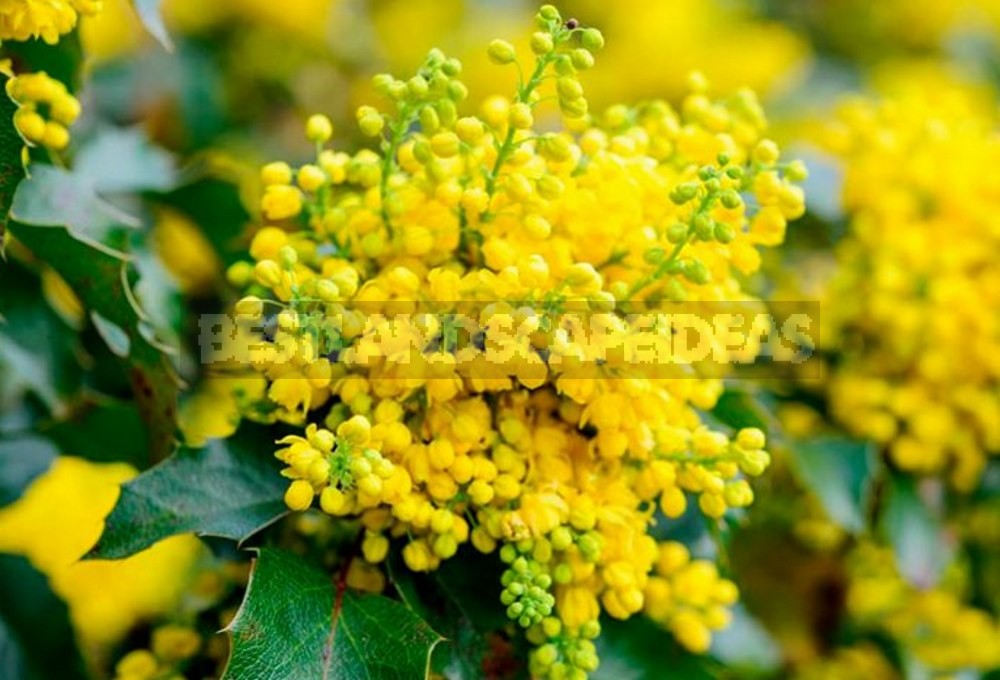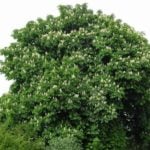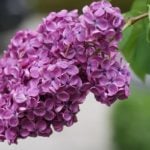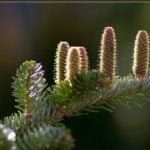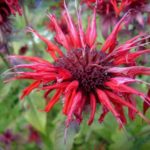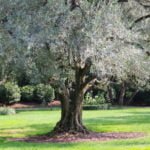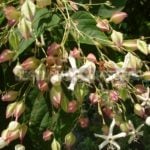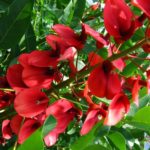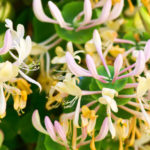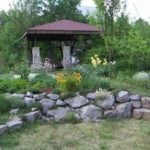Mahonia aquifolium was introduced from North America to Europe sometime in the 19th century and immediately gained well-deserved popularity among those who like to improve their gardens.
The mahonia is represented by shrubs and trees and belongs to the barberry family. Magonia in the wild can be found in the eastern and central regions of Asia, as well as in North America. This genus was named in honor of the American gardener from Ireland, Bernard McMahon, who was engaged in the fact that in the eastern United States he acclimatized plants that he brought from the western part of the country. He also became famous for being the first to create an American garden calendar. This genus unites about 50 species. Magonia is the type species of this genus, where it comes from, it is also called “Oregon grape”. This shade-loving plant is highly resistant to frost and drought, as well as undemanding to the ground.
This plant is considered decorative, not everyone knows that its berries are edible and have a pleasant, I would say, delicious dessert taste. So, having admired enough bunches of dark blue berries, you can treat yourself and eat them. Magonia berries have the ability to lower high blood pressure. Remaining on the bush, they do not lose their original taste and useful properties for 4-5 months.
Features

Magonia is an evergreen shrub, reaching a height of about 1m (3.2 ft). It has abundant root growth. On the old stems, the bark is brown-gray, and on the young ones — grayish-pink. The non-pinnate compound leaf plates have light red petioles and consist of 5-9 sharp-toothed, notched leaves that are 15-25 millimeters (0.5 inch) wide and 3-9 cm (3.5 inch) long. Such leaves are dark green, leathery, their front surface is shiny, and the underside is matte. Multi-flowered axillary racemes or panicle-shaped inflorescences consist of bright flowers of pale yellow color (sometimes found with a lemon tint), the diameter of which can reach 0.8 cm. The fruits are oblong-elliptical berries, painted in black and blue, on their surface there is a thick coating of bluish plaque, as well as a cannon. In length, such berries reach 1 cm (0.4 inch), and in width – 0.8 cm (0.3 inch), they have a fairly pleasant sweet and sour taste and are used in confectionery production, as well as they color wines. Flowering occurs in April and May, with the berries maturing in September or August.
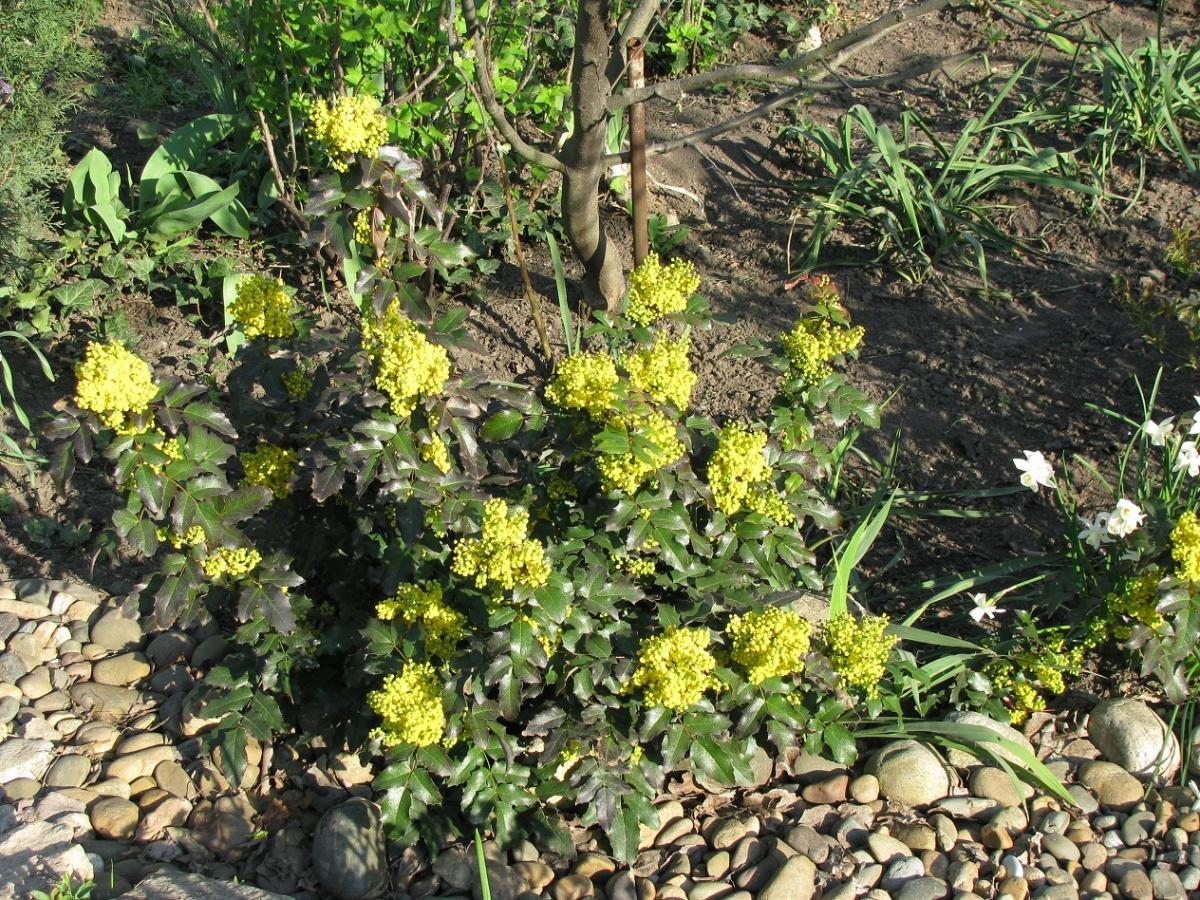
In landscape design, this plant is used to create borders, low hedges, group plantings, it is also planted solo or used for lining high shrubs. In winter, the shiny leaf plates change their color to green with a beautiful red hue. Also, this shrub looks very impressive during the ripening of purple-blue berries covered with a waxy coating.
Growing in the Open Ground
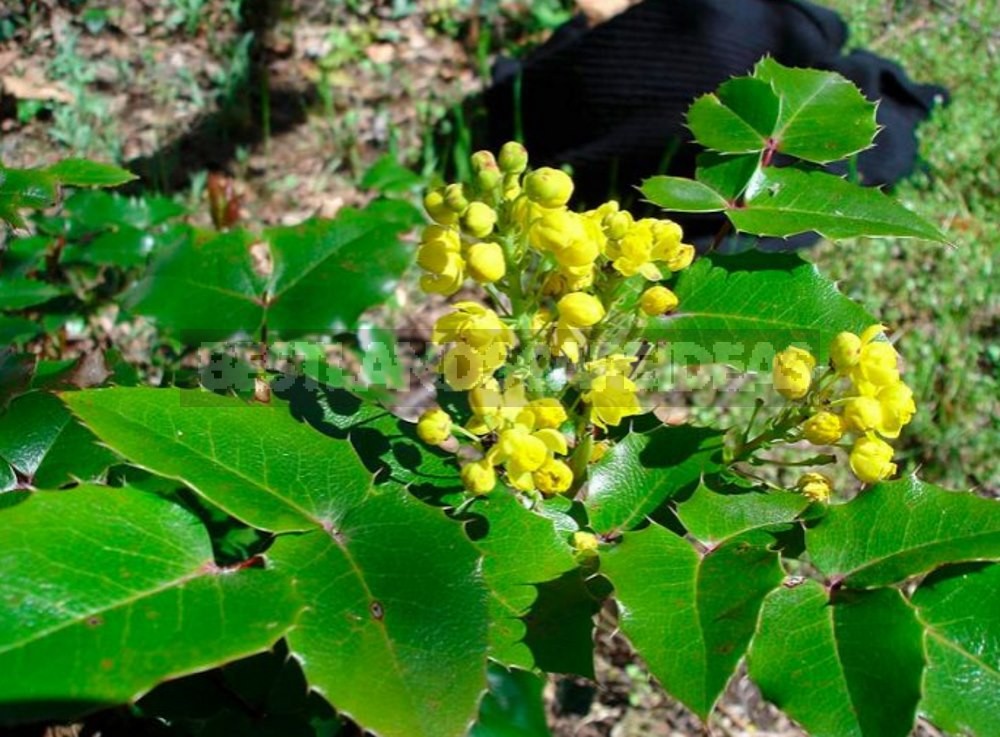
Planting of magonia in open soil is carried out in the spring. In this case, before the onset of frost, the plant will take root well and begin to grow actively. However, many gardeners quite successfully plant such a shrub in both summer and autumn. Its landing should not be carried out only in late autumn and winter.
For landing, you should choose a well-lit area that has reliable protection from strong gusts of wind. Also, the shrub can be grown in a small shade, only in this case, a rich harvest of berries will definitely not be. When choosing a place for planting, it should also be taken into account that the direct rays of the sun can injure the delicate leaf plates of magonia, so it is best that the selected site is located in the lacy penumbra of tall trees.
The soil must be necessarily loose, rich in nutrients and with a high content of humus. In order to fill the planting pit during the planting of the seedling, prepare a mixture consisting of humus, turf soil and sand (2:1:1).
Planting Features
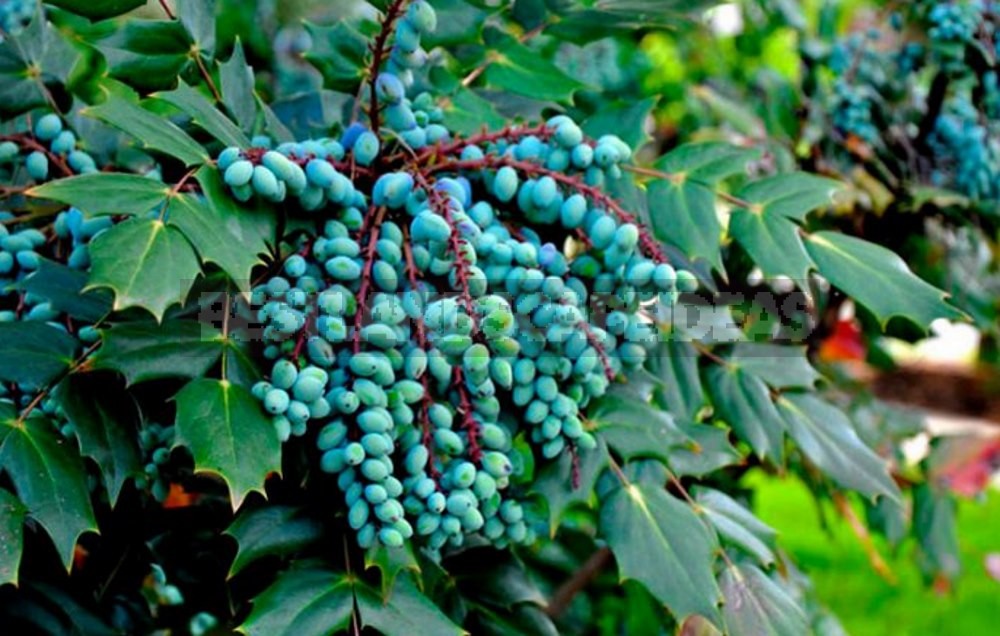
Preparing the pit for planting should be done half a month before the scheduled landing date. The size of the landing pit should be equal to 0.5×0.5×0.5 m (20x20x20 inch). In the event that the soil on the selected site is heavy clay, then the depth of the pit should be increased, since at its bottom you will need to make a drainage layer. After everything is ready, fill the hole with 1/2 part of the soil mixture, the composition of which is described above. After 14 days, the compaction and subsidence of this soil should occur. When creating a border or a hedge between the specimens, a distance of 1 m (3.2 ft) should be observed. In the event that you create a loose landing, the distance between the bushes should be equal to two meters.
Before you plant a seedling, make a thorough inspection of its root system, while you need to remove the dried and diseased roots, as well as shorten too long ones. Places of cuts should be sprinkled with crushed charcoal. When both the seedling and the planting pit are ready, you can start planting. To do this, the root system must be placed in a pit that is filled with a soil-mixture (its composition is described above). When planting, make sure that the root neck of the plant rises slightly above the surface of the soil. The ground in the trunk circle should be thoroughly compacted, and also along the perimeter it is necessary to make a roller from the ground of a ten-centimeter height. Planted magonia needs abundant watering, so, under each bush, 20 liters ( 5.2 gal) of water should be poured. After the liquid is completely absorbed into the ground, the surface of the trunk circle should be covered with a layer of mulch.
Care for Magonia
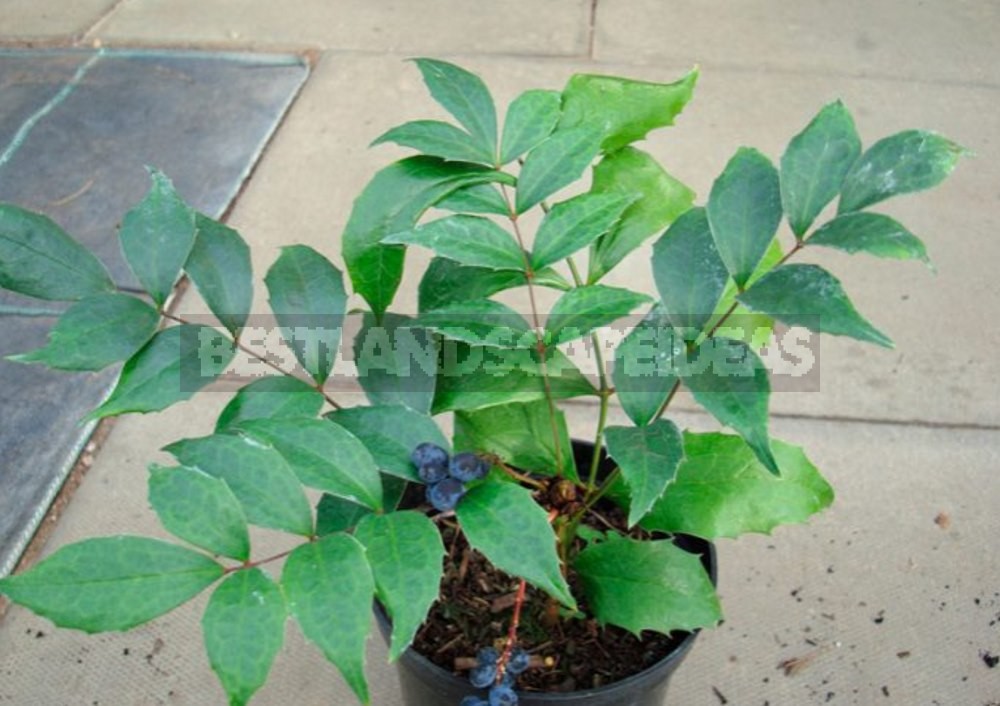
Caring for magonia is not much different from caring for other garden shrubs. Such a plant must be provided with systematic watering, timely fertilizing, weeding and loosening of the soil. Sometimes in the evening, you can spray the crown of the plant with water. The first pruning is done after the age of the bush reaches 10 years. It is also necessary to treat magonia from pests and diseases as necessary.
How to Water
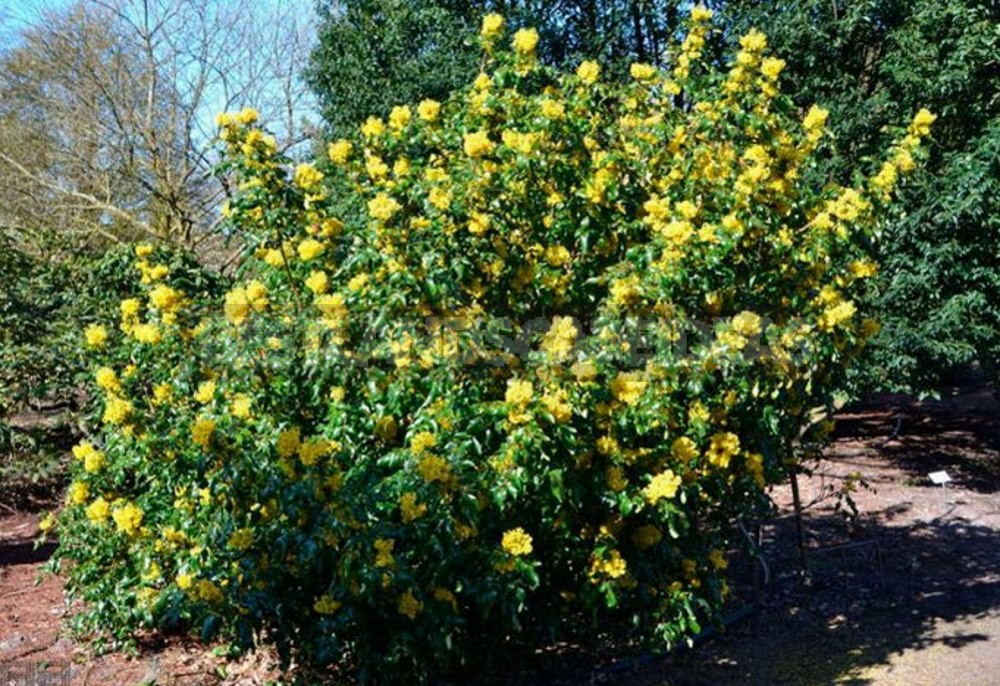
This moisture-loving plant especially needs abundant watering at a young age. After the seedling is planted, it is watered abundantly. When watering the shrub, do not forget to spray the crown with water. Watering is recommended in the evening, when there will no longer be scorching sunlight. Adult specimens need watering, as a rule, only in the dry period, and this procedure should be performed twice a week, pouring 1 bucket of water under each bush. If the rains are systematic, then it will be possible not to water the plants at all. The surface of the trunk circle must be loosened to a not very large depth on the next day after watering or precipitation.
Top Dressing
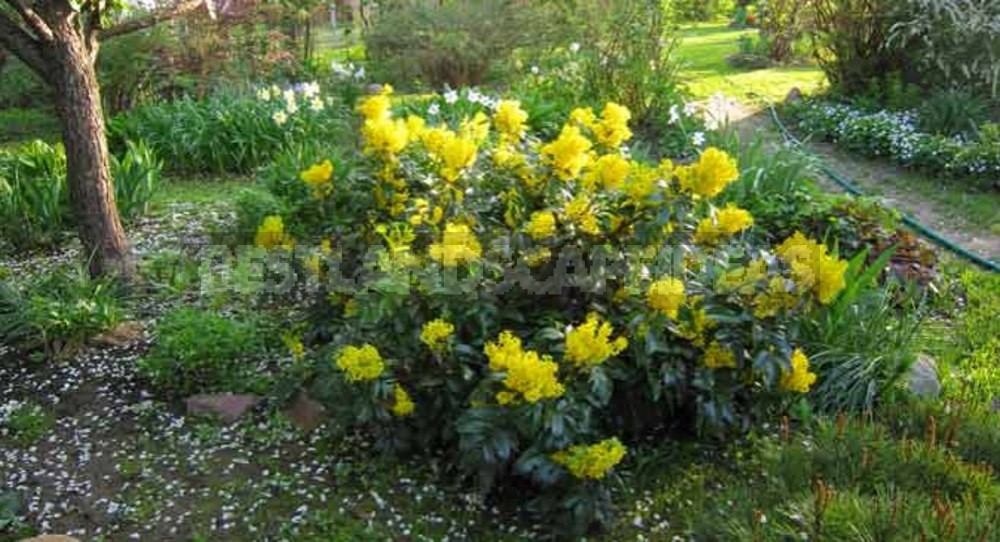
Top Dressing of the shrub should be done twice per season, namely, at the very beginning of the spring period and in May, before it blooms. Feed the plant with mineral complexes, for example, concentrated nitrogen-phosphorus-potassium granular mineral fertilizer. For 1 square meter, 100 grams (3.5 oz) of the nutrient is taken. In the autumn, the surface of the magonia tree trunk circle must be covered with a five-centimeter layer of mulch (humus or compost). In the spring, you should dig up the soil together with the mulch.
Replanting
This shrub can be transplanted during the entire growing season. However, it is better not to do this in late autumn, as with the onset of frost, the plant can die due to the fact that it did not have time to properly take root. Magonia tolerates the transplant quite well, and this procedure should be performed almost in the same way as the initial landing.
Pruning
In early spring, before the buds swell, you need to make a sanitary pruning. To do this, you need to cut off all the injured, damaged by disease, pests or frosts, as well as dried and weakened branches. In order to preserve the splendor and compactness of the bushes, they must be cut after they bloom or in the autumn. At the same time, remember that the laying of flower buds occurs on last year’s shoots, so they should not be shortened by more than ½ part. If the plant is already very old, then if desired, you can make a rejuvenating pruning, which the plant tolerates very well.
If you want your mahonia to remain low, with dense foliage, cut it off immediately after flowering or in late autumn. Please remember that flower buds in spring will only form on the previous year’s increments, so the maximum amount of branch length can be removed so that you can enjoy their half-blooming next year.
Reproduction
It is best to use reproduction exclusively by cuttings, in my opinion, this is much faster and easier than growing magonia from seeds. Judge for yourself, if the kernel, transplanted in the fall, will bloom in the spring, then with the seeds it is much longer. For example, if you plant seeds immediately after they are harvested, that they do not need stratification, in winter they get it naturally. They will be suitable for transplanting only after two years, and will bloom only at the age of 4-5 years!
How to Grow from Seed
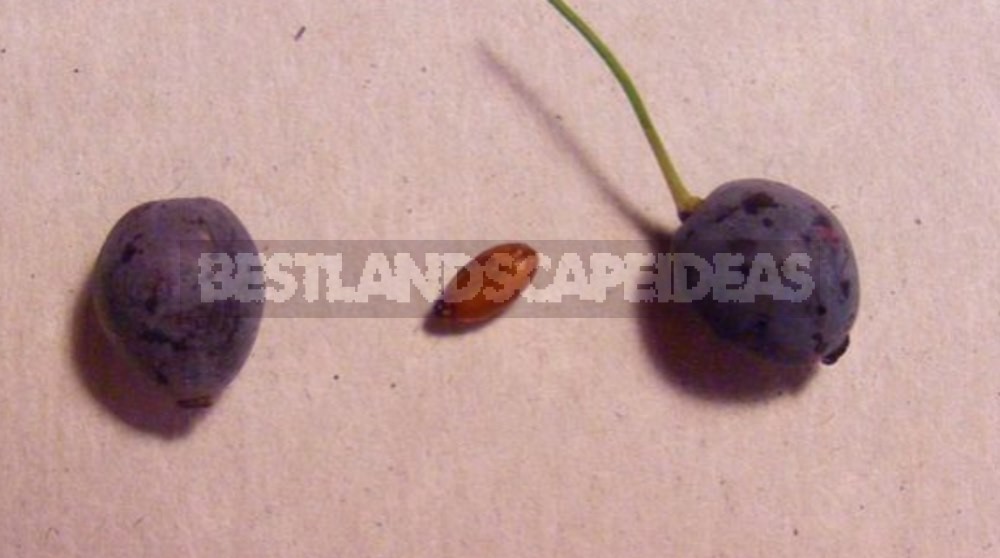
Seeds are sown in open soil in the autumn immediately after collection, while they should be buried in the ground no more than 20 mm (0.8 inch). Sowing can also be done in the spring, but in this case, the seeds will need to be stratified for 4 months at a temperature of 0-5 degrees (32-41°F). Newly emerged seedlings will need reliable protection from direct sunlight. In the autumn, thinning or planting seedlings in individual containers is carried out. After another 1-1.5 years, the seedlings can be transplanted into the open ground for a permanent place. Do not forget to cover the first 2 or 3 of the first winter with young plants and cover them with snow. Such a shrub, grown generatively, will bloom only at the age of four.
How to Grow from Cuttings
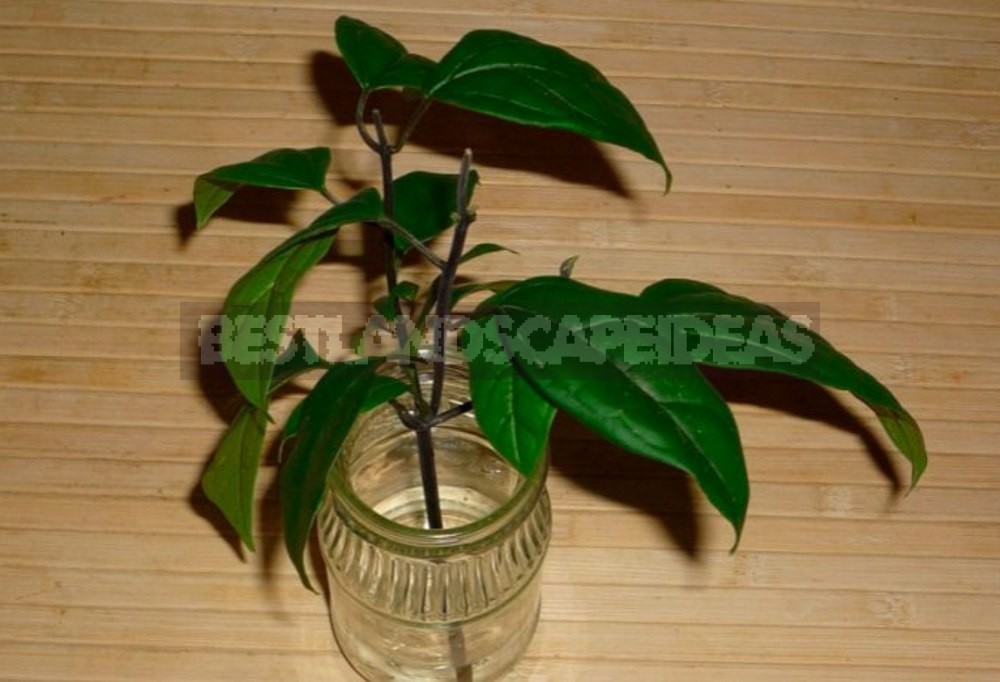
Harvesting of cuttings is carried out at the very beginning of spring before the buds swell. Remember that each stalk should have 6 buds. Cuttings should be immersed in a container with water placed in the garden, while only half of them should be in the liquid. After about 8 weeks, the roots will grow from the buds that are located in the lower part of the cuttings. After the length of the roots will reach 7 centimeters (2.8 inch), the stalk should be planted in open soil and covered with a plastic bottle, which has a pre-cut neck. After 1.5 weeks, the bottles are left only for the night, and they are removed for the day, this will allow the plant to gradually get used to the new conditions.
How to Multiply by Layering
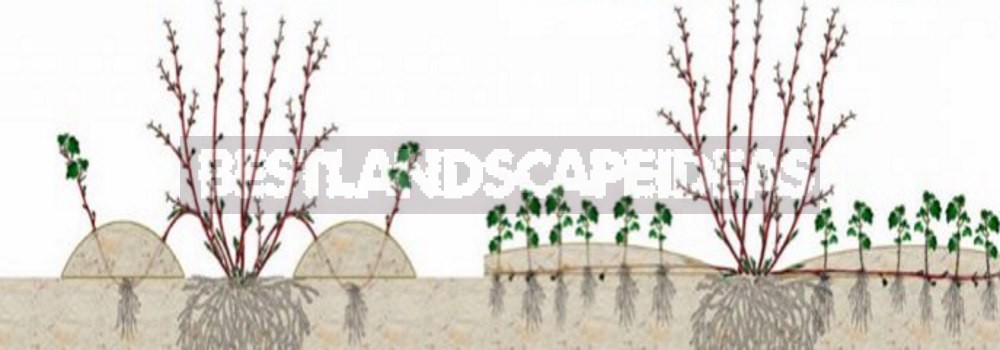
In the spring, you need to choose a strong growth shoot. It bends down to the ground surface, fits into a pre-prepared groove and is fixed in this position. In this case, the tip of the stem should remain above the surface of the soil. Then the groove should be filled with soil. When watering the shrub in the summer, do not forget about the layering. The rooted branch can be cut off from the parent bush and transplanted to a new permanent place only next spring.
Pests and Diseases
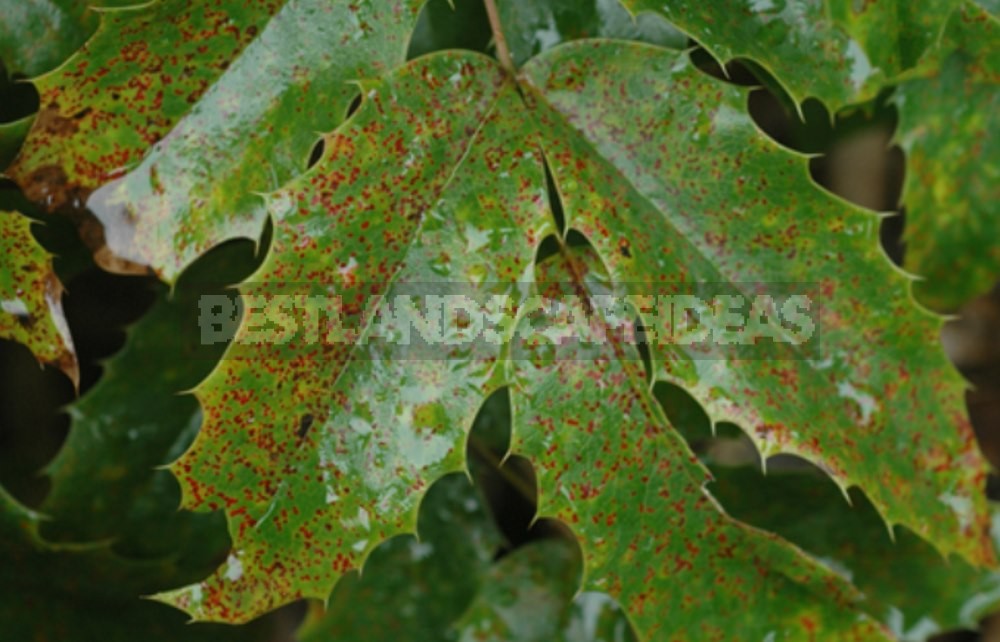
Magnesium has a very high resistance to diseases and pests. However, in some cases, such a shrub is affected by fungal diseases such as: rust, powdery mildew and spotting (stagonosporosis and phyllosticosis).
In order to get rid of powdery mildew, the affected shrub must be treated 1 time in 10-12 days with a solution of a fungicide. To cure magonia from rust, it should also be sprayed with fungicides.
If large spots of brown color appear on the leaf plates of the plant, it means that it is affected by phyllostycosis. On the front side of such spots, pycnids appear. During the season, such a fungus can give several generations. The affected bushes lose their spectacular appearance, their leaf plates die off before the due date, the flowering becomes less lush and the yield is significantly reduced.
If there are oval-shaped spots with a dark border along the edge of the leaf plates, this indicates that the bush is infected with stagonosporosis. Rounded pycnids appear on the front surface of the spots. The infected shrub first loses its spectacular appearance, and then completely dies.
To get rid of spotting, it is necessary to collect and burn all the overwintered foliage in the spring. Then the bushes are treated with Oxychom spray. This should be done before the juice movement begins.
Best Varieties with Photos and Names
Мahonia Repens
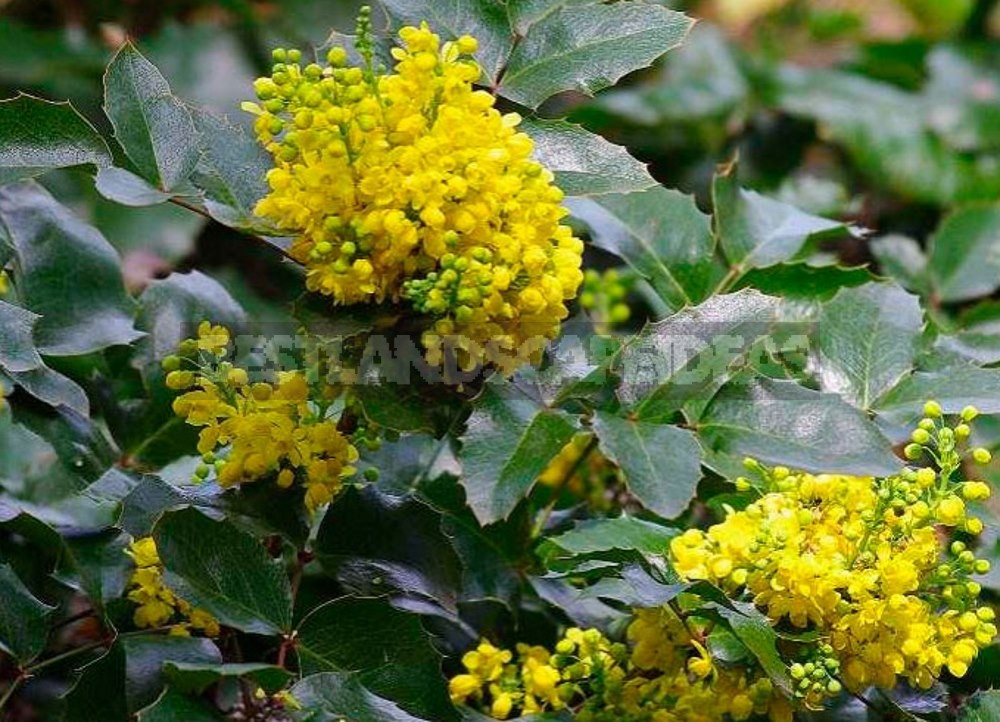
The birthplace of this species is North America, at the moment it is not very popular with gardeners. The bush almost never exceeds 0.5 m (1.6 ft) in height. The leaf blades consist of 3 to 7 ovate-rounded pale greenish-glaucous leaflets, they are leathery and have a sharp-toothed edge. Inflorescences of yellow-lemon color appear in mid-May, and then again in the last days of September. The ripening of the berries ends in mid-August. This species has a higher winter tolerance compared to Magonia padubolistnaya, but its appearance is not so spectacular. There are 2 decorative shapes available: Round-leaved (The composition of the leaf plate includes 5 leaves of a rounded shape). As well as large-fruited options.
Mahonia Japonica
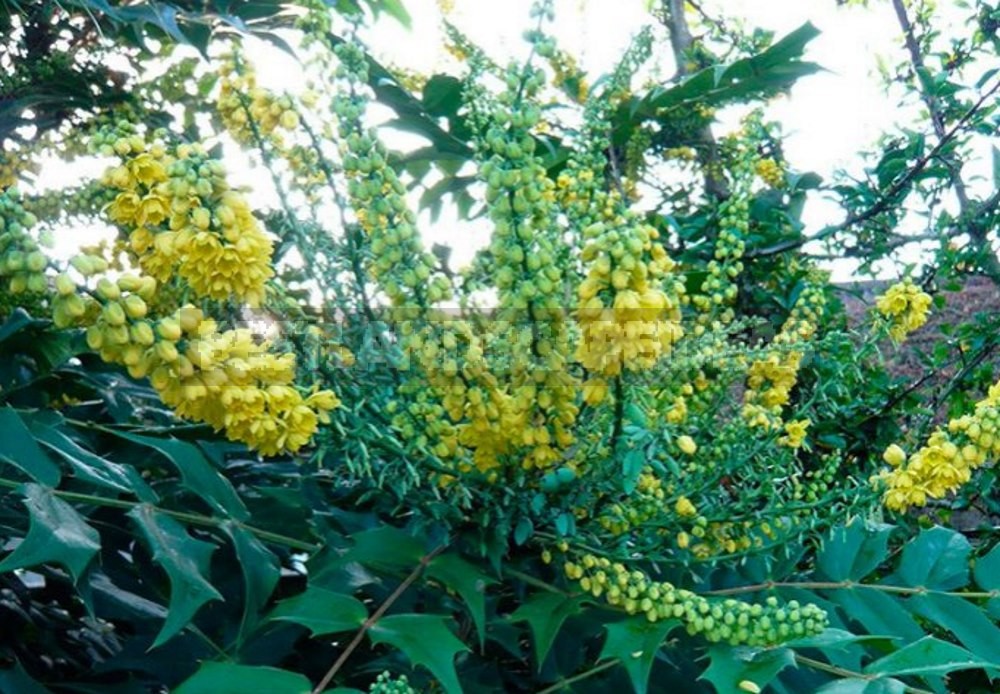
It is found naturally in Japan, America, China, and Europe. Flowering is observed from the last days of December until the beginning of spring. In height, such a large bush can reach 2 m (6.5 ft). It has an unusual and extremely spectacular shape. Its straight shoots stick out in different directions. It blooms with yellow racemes, from which the fragrance of lily of the valley comes.
Мahonia х media Winter sun
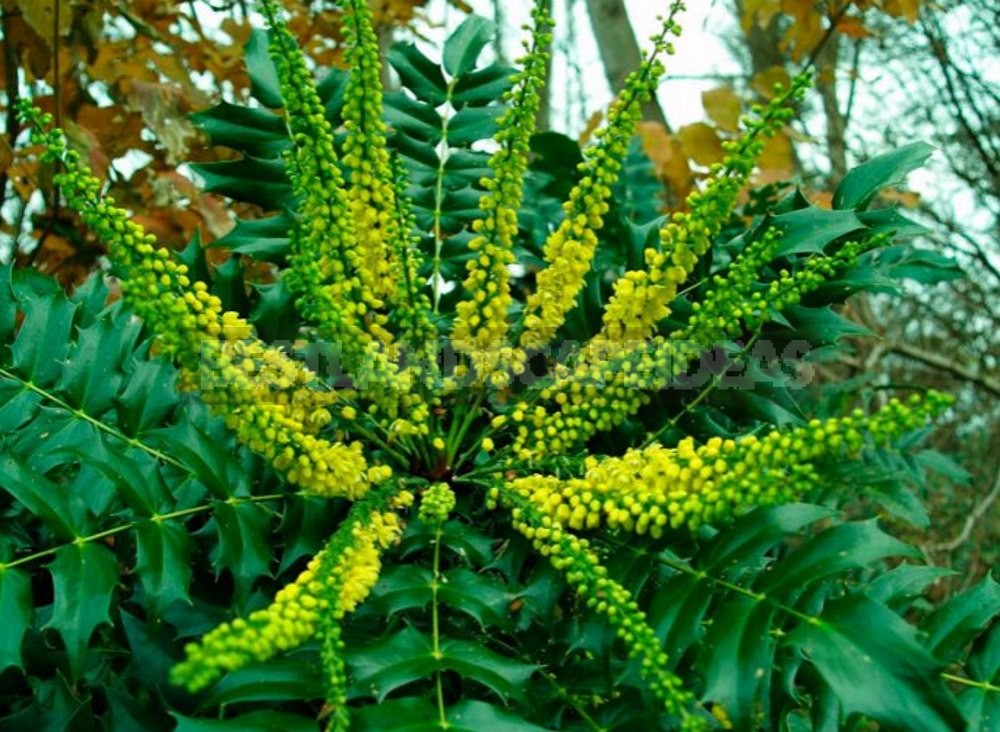
This hybrid plant was obtained as a result of crossing Magonia lomarielistnaya and Magonia Japonica. The height of the bush is about 2 meters (6.5 ft). In the middle latitudes, this hybrid is cultivated only in greenhouses, since its flowering is observed in winter.
Мahonia Fremontii
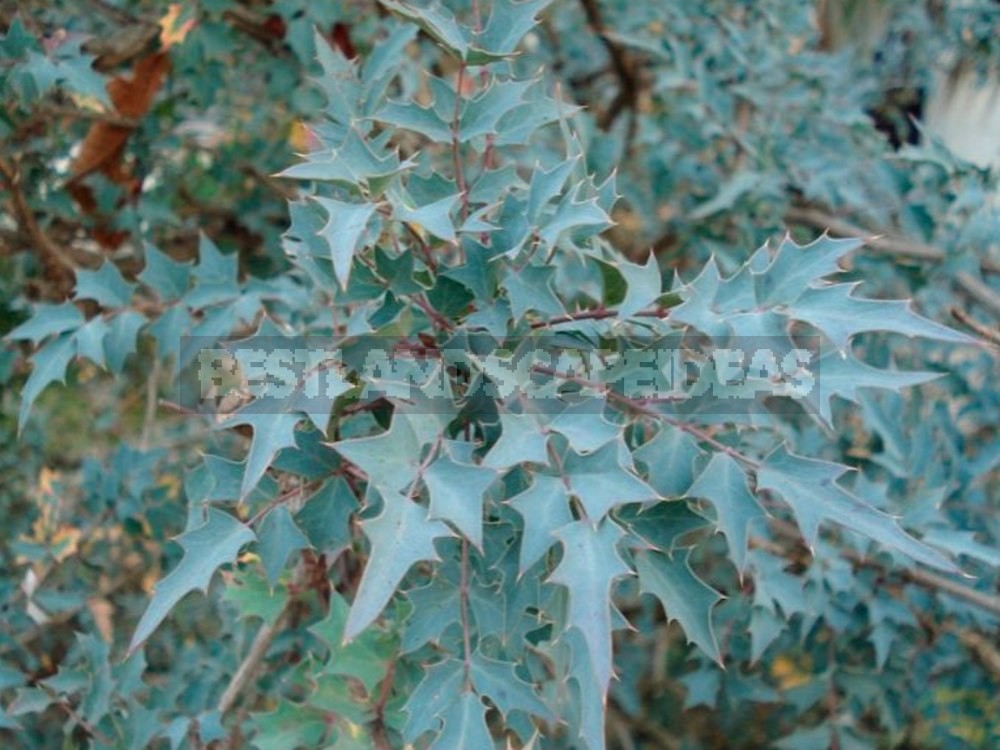
This species is native to the west coast of the United States in height can reach 3 meters (10 ft). The color of the inflorescences is light yellow, and the berries are purple-red. While the plant is young, its leaf plates have a purple hue, in the adult shrubs they are green, and in the old — bluish-gray.
Мahonia eurybracteata Soft Caress
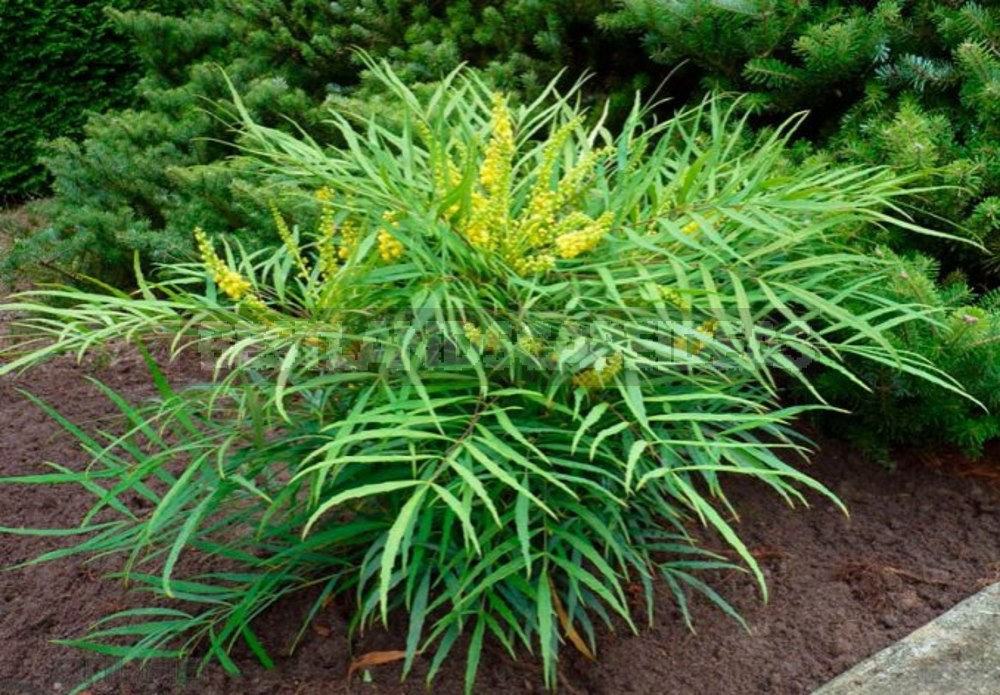
This spectacular Chinese plant has very elegant thin leaf plates. As a rule, a container is used for growing this variety.
